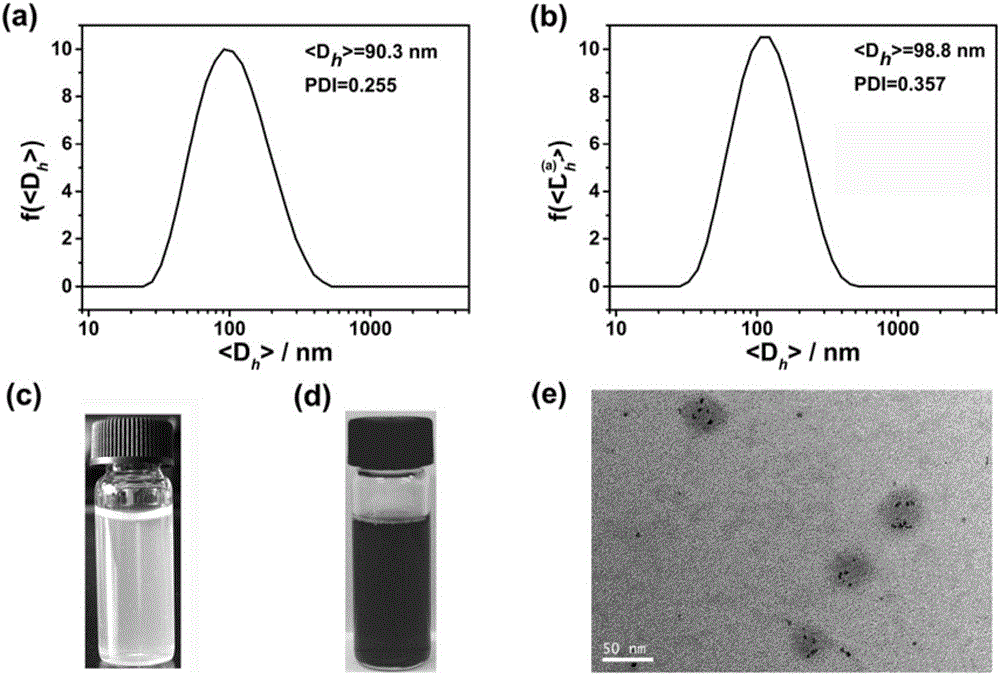Preparation method and application of drug controlled release nano-system sensitive to tumor microenvironment
A tumor microenvironment and drug controlled release technology, applied in the field of drug controlled release, to achieve the effect of improving the ability to enter cells, promoting adhesion, and high yield
- Summary
- Abstract
- Description
- Claims
- Application Information
AI Technical Summary
Problems solved by technology
Method used
Image
Examples
Embodiment 1
[0026] Step A: Preparation of reduction-sensitive nanoparticles based on dextran-methacrylic acid system: Dissolve 1.00 g of dextran (molecular weight of 40,000 Da) in 100 mL of water, stir until fully dissolved, pass nitrogen to deoxidize for 1 hour, and A dilute nitric acid solution containing 0.47 g of ammonium cerium nitrate was added under nitrogen protection and uniform stirring, so that the final pH of the reaction system was between 1-2. After about 5 minutes, 0.50 mL of methacrylic acid monomer was added, and half an hour later, 0.096 g of diallyl disulfide crosslinking agent (dissolved in 1 mL of dimethyl sulfoxide solution) was added, and the reaction was carried out at 30° C. for 4 hours. After the reaction, dialyze in pure water for one week to ensure the removal of impurities such as unreacted monomers in the reaction system, that is, to obtain a reducing environment-sensitive nanoparticle aqueous solution based on the dextran-acrylic acid system, and obtain nanop...
Embodiment 2
[0031]Step A: Preparation of reduction-sensitive nanoparticles based on the dextran-hydroxyethyl acrylate system: Dissolve 1.00 g of dextran (molecular weight: 40,000 Da) in 100 mL of water, stir until fully dissolved, and deoxidize with nitrogen for 1 hour, Under nitrogen protection and uniform stirring, dilute nitric acid solution containing 0.47 g of ceric ammonium nitrate was added to make the final pH of the reaction system between 1-2. After about 5 minutes, 0.62 mL of hydroxyethyl acrylate monomer was added, and half an hour later, 0.096 g of diallyl disulfide crosslinking agent (dissolved in 1 mL of dimethyl sulfoxide solution) was added, and the reaction was carried out at 30°C for 4 hours. After the reaction, dialyze in pure water for one week to ensure the removal of impurities such as unreacted monomers in the reaction system, that is, to obtain a reducing environment-sensitive nanoparticle aqueous solution based on the dextran-methyl acrylate system, which is obtai...
Embodiment 3
[0036] Step A: Preparation of temperature-sensitive reduction-sensitive nanoparticles based on hydroxypropyl cellulose-glycidyl methacrylate system: 0.6 g of temperature-sensitive hydroxypropyl cellulose (molecular weight 80,000 Da) Dissolve in 50mL water, stir until fully dissolved, pass argon for 1 hour to remove oxygen in the system, add 0.08g dilute nitric acid solution of ammonium cerium nitrate under argon protection and uniform stirring, so that the final pH of the reaction system is at 1- between 2. After about 10 minutes, 0.32 mL of glycidyl methacrylate was added, and after 30 minutes, 0.080 g of bisacrylcystamine cross-linking agent (dissolved in an appropriate amount of aqueous solution) was added and reacted at 30° C. for 4 hours. After the reaction is over, transfer to a dialysis bag and dialyze in pure water for three days to ensure removal of impurities such as unreacted monomers in the reaction system, that is, to obtain a hydroxypropyl cellulose-glycidyl meth...
PUM
| Property | Measurement | Unit |
|---|---|---|
| particle diameter | aaaaa | aaaaa |
| hydrodynamic diameter | aaaaa | aaaaa |
| hydrodynamic diameter | aaaaa | aaaaa |
Abstract
Description
Claims
Application Information
 Login to View More
Login to View More - R&D
- Intellectual Property
- Life Sciences
- Materials
- Tech Scout
- Unparalleled Data Quality
- Higher Quality Content
- 60% Fewer Hallucinations
Browse by: Latest US Patents, China's latest patents, Technical Efficacy Thesaurus, Application Domain, Technology Topic, Popular Technical Reports.
© 2025 PatSnap. All rights reserved.Legal|Privacy policy|Modern Slavery Act Transparency Statement|Sitemap|About US| Contact US: help@patsnap.com

